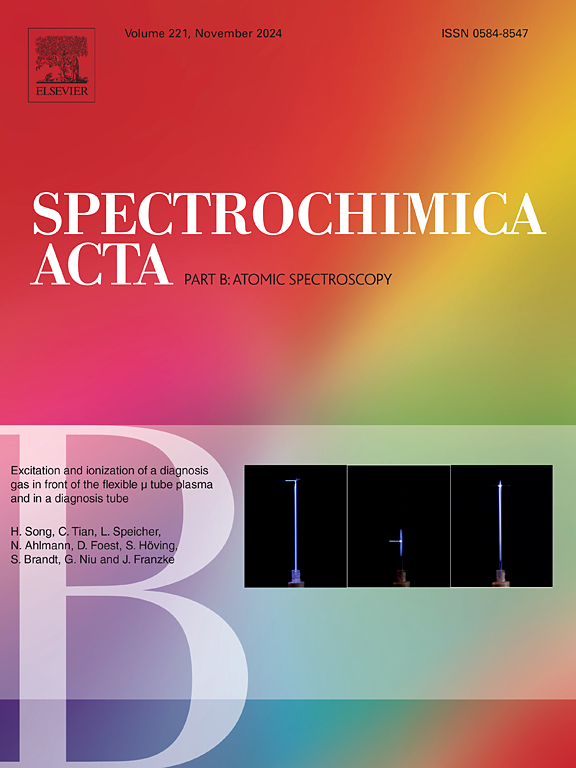Total-reflection X-ray fluorescence analysis (TXRF) of plant's guttation fluids as a new, fast, and non-invasive strategy for the assessment of the bioavailability of Zn, Cd and Pb in contaminated soils
IF 3.8
2区 化学
Q1 SPECTROSCOPY
引用次数: 0
Abstract
The assessment of potentially toxic elements (PTE) concentration in biofluids is often used for the evaluation of their bioavailability in polluted environments. In the soil-plant system, the analysis of the composition of the xylem fluid can provide a real snapshot of the elements taken up from the soil by the plant. However, xylem collection is often difficult, and, for herbaceous plants, it requires cutting the plant. Alternatively, xylem can be collected through leaves as naturally exuded drops (i.e. guttation), thus in a fully non-destructive way. The guttation phenomenon is yet limited to micro-volumes, therefore the analysis with most techniques is challenging. For the first time, the capability and reliability of total-reflection X-ray fluorescence (TXRF) spectrometry for the quantification of PTE in plant's guttation fluids was tested in this work. In particular, the study was led on fluids sampled from Lolium rigidum plants grown in a soil contaminated with Zn, Cd, and Pb. Two different TXRF spectrometers were used and compared, equipped either with Mo- or W-anode-based X-ray sources; inductively coupled plasma optical emission spectroscopy (ICP-OES) and graphite furnace atomic absorption spectrometry GF-AAS were used as reference techniques. Differently from these latter, approximately 30 μL of sample were sufficient for the quantification of Zn, Cd, and Pb through TXRF (along with the determination of other essential plant nutrients). Furthermore, the comparison with ICP-OES and/or GF-AAS showed various improvements in using TXRF, including a fast sample preparation, a reduced use of chemicals, the multi-elemental capability. These results suggest that TXRF analysis of plant guttation fluids could represent a novel non-destructive, expeditious and “green” analytical approach for the study of Zn, Cd, Pb and other PTE availability in polluted soils.

全反射x射线荧光分析(TXRF)是一种新的、快速的、无创的评价污染土壤中Zn、Cd和Pb生物有效性的方法
生物流体中潜在有毒元素(PTE)浓度的评估通常用于评价其在污染环境中的生物利用度。在土壤-植物系统中,对木质部液体成分的分析可以提供植物从土壤中吸收元素的真实快照。然而,收集木质部通常是困难的,而且,对于草本植物,它需要切割植物。另外,木质部也可以通过叶片自然渗出的液滴(即木质部脱落)收集,从而以一种完全无损的方式收集。沟槽现象仍然局限于微体积,因此大多数技术的分析是具有挑战性的。本文首次验证了全反射x射线荧光(TXRF)光谱法定量测定植物内脏液中PTE的能力和可靠性。特别是,这项研究是对生长在被锌、镉和铅污染的土壤中的黑麦草(Lolium rigum)植物的液体取样进行的。使用并比较了两种不同的TXRF光谱仪,分别配备Mo或w阳极x射线源;以电感耦合等离子体发射光谱法(ICP-OES)和石墨炉原子吸收光谱法(GF-AAS)为参比技术。与后者不同的是,大约30 μL的样品足以通过TXRF定量Zn、Cd和Pb(以及其他植物必需营养素的测定)。此外,与ICP-OES和/或GF-AAS的比较显示了使用TXRF的各种改进,包括快速样品制备,减少化学品使用,多元素能力。这些结果表明,植物渗液TXRF分析可以为研究污染土壤中Zn、Cd、Pb和其他PTE有效性提供一种新的、无损的、快速的“绿色”分析方法。
本文章由计算机程序翻译,如有差异,请以英文原文为准。
求助全文
约1分钟内获得全文
求助全文
来源期刊
CiteScore
6.10
自引率
12.10%
发文量
173
审稿时长
81 days
期刊介绍:
Spectrochimica Acta Part B: Atomic Spectroscopy, is intended for the rapid publication of both original work and reviews in the following fields:
Atomic Emission (AES), Atomic Absorption (AAS) and Atomic Fluorescence (AFS) spectroscopy;
Mass Spectrometry (MS) for inorganic analysis covering Spark Source (SS-MS), Inductively Coupled Plasma (ICP-MS), Glow Discharge (GD-MS), and Secondary Ion Mass Spectrometry (SIMS).
Laser induced atomic spectroscopy for inorganic analysis, including non-linear optical laser spectroscopy, covering Laser Enhanced Ionization (LEI), Laser Induced Fluorescence (LIF), Resonance Ionization Spectroscopy (RIS) and Resonance Ionization Mass Spectrometry (RIMS); Laser Induced Breakdown Spectroscopy (LIBS); Cavity Ringdown Spectroscopy (CRDS), Laser Ablation Inductively Coupled Plasma Atomic Emission Spectroscopy (LA-ICP-AES) and Laser Ablation Inductively Coupled Plasma Mass Spectrometry (LA-ICP-MS).
X-ray spectrometry, X-ray Optics and Microanalysis, including X-ray fluorescence spectrometry (XRF) and related techniques, in particular Total-reflection X-ray Fluorescence Spectrometry (TXRF), and Synchrotron Radiation-excited Total reflection XRF (SR-TXRF).
Manuscripts dealing with (i) fundamentals, (ii) methodology development, (iii)instrumentation, and (iv) applications, can be submitted for publication.

 求助内容:
求助内容: 应助结果提醒方式:
应助结果提醒方式:


